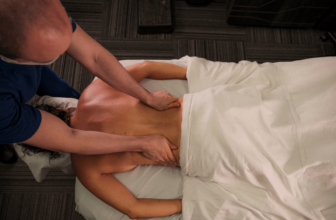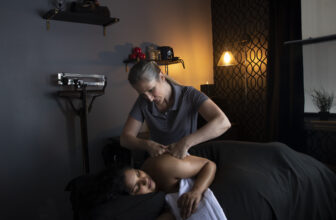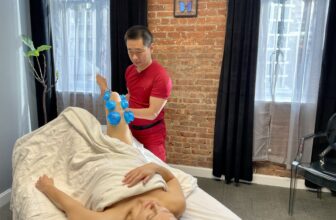
[adinserter block=”2″]
What is a knot?
I get asked all the time as I work on a knot, “What is that?” What causes that?” A simple explanation is that a knot is a tight ball of muscle from an overworked muscle. I have been asked if a knot is when two or more muscles become intertwined. A good question because actually fibers within the same muscle can become intertwined as can fibers from separate muscles that share an attachment of the same bone. Try not to think of a knot as a “knot” in the traditional sense though. There is no wrapping into a bow or sailor’s knot of our muscles as the term can easily be misconstrued. Instead think of the knot as a muscle spasm.
To understand what a knot is, it is important to distinguish the normal physiology of muscles. Most of the time, our muscles operate in an on/off manner. That means the muscles that get sore and fatigue easily, the fast twitch fibers (the white meat as opposed to dark meat) that enable us to perform rapid, intense movements of short duration like weight training or throwing a ball are not always at work. They fire or contract during exertion but when the exertion is completed they quit firing. It is when they continue to fire or contract without releasing that a spasm or muscle knot forms. So how does this occur? A fatigable muscle in spasm contains individual sections within the muscle that constrict and pull from both sides. This makes a taut band of muscle essentially forming what is known as a knot.
There are direct and indirect causes of knots. One of the most common causes is overwork. Remember, these fast twitch fibers are not meant to be used for long periods of time. The next time you are working out, try doing one more set of 15 reps of what you are lifting and determine if that last set was as easy as the first set. So overworking muscles can cause knots. Trauma, such as can happen in an automobile accident or physical activity or injury, also contributes to knot formation. The stress that we encounter on a daily basis help form the shoulder and neck knots that we all are accustomed to at some point or another. One of my favorite bumper stickers is “Stress is the inability to reach out and strangle someone who desperately needs it” Since we cannot strangle the person who cuts you off on the highway or cuts in front of you in line at the grocery store, we tend to take that “energy” and keep it “balled” inside. So our neck constricts, our shoulders raise and before long if we cannot calm down and realize that Life is just too short to worry about such trivial matters, then those poor muscles that make our shoulders look like earrings remain overworked by contracting and firing too much/too long. Therefore tension knots occur.
So how does massage therapy help in getting rid of our knots and decreasing the associated pain and discomfort? First let’s review what we know about massage. The number one benefit of massage is relaxation. By that I mean, when a person experiences massage, whether Swedish, Deep Tissue, Thai, Shiatsu the list goes on, the primary response to touch is that the parasympathetic nervous system or rather the nervous system that enables us to rest and digest is activated. This means that during your massage session, your body, that is your much more relaxed body, is able to function much more effectively, efficiently, and optimally because it is undergoing a restorative phase. Therefore our circulatory system works optimally and increases circulation which carries blood and nutrients to other systems in our body. Thus these systems operate more efficiently too. Our liver detoxifies and the lymphatic system operates advantageously thus reducing toxins in the body. And what of the toxins that are the chemical makeup of a knot? Because it is thought that a knot can contain excess lactic acid, unusual deposits of protein and other bodily by-products more commonly referred to as “toxins”, massage both directly and indirectly has an effect on the removal of wasteful by-products.
Trigger Point therapy directly aids in the reduction of knots with a massage technique called sustained compression. Translation: the massage therapist locates the knot and applies deep compression with a thumb, fingers, or elbow and holds until the pain and discomfort dissipates (usually 20-30 seconds and is repeated several times). This is done with patient/therapist awareness and focus on breath and thought. Trigger Point therapy can be painful but if done correctly by a legitimate massage therapist can be the difference between chronic pain caused by muscle knots and a freer, more mobile, happier you.
Contact us today to book your massage
[adinserter block=”2]
Credit : Source Post






